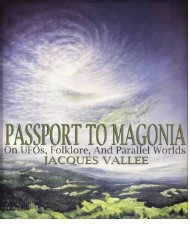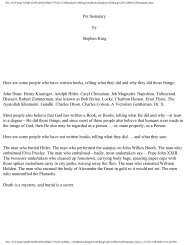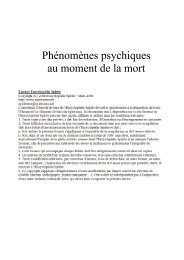extraordinary%20encounters
extraordinary%20encounters
extraordinary%20encounters
You also want an ePaper? Increase the reach of your titles
YUMPU automatically turns print PDFs into web optimized ePapers that Google loves.
122 Hollow earth<br />
rior. Some beliefs have it that the spirits of the<br />
unsaved dead live on in gloom or torment beneath<br />
our feet. The most famous scientific<br />
proponent of a hollow earth, Edmond Halley<br />
(1656–1743), best remembered for the comet<br />
named after him, argued that within the<br />
earth’s sphere there were three other, smaller<br />
ones, all harboring intelligent beings. Theories<br />
about a hollow earth, while dismissed as physically<br />
impossible by scientists, continue on the<br />
fringes into modern times.<br />
John Cleeves Symmes (1779–1829) became<br />
a notorious figure in early American history<br />
as a vigorous publicist for the notion first<br />
proposed by Halley, of an earth whose interior<br />
consisted of concentric spheres. According to<br />
Symmes, the interior could be entered<br />
through four-thousand-mile-wide holes at either<br />
pole. Symmes hoped to lead an expedition<br />
into the earth, and he lectured widely, all<br />
the while lobbying for funding. In the face of<br />
national ridicule, he argued that the people of<br />
the interior amounted to a vast new market<br />
for American goods. Symmes inspired Edgar<br />
Allan Poe to write the classic proto-sciencefiction<br />
novella The Narrative of Arthur Gordon<br />
Pym (1838). Symmes’s son Americus kept the<br />
faith after his father had passed on. As late as<br />
1878 he published a collection of the elder<br />
Symmes’s writings and lectures.<br />
The 1870s and 1880s saw a hollow - e a rt h<br />
re v i val with the publication of still other books<br />
championing the notion, including M. L .<br />
Sh e r m a n’s The Ho l l ow Gl o b e (1871), a channeled<br />
work, and Frederick Cu l m e r’s The In n e r<br />
Wo rl d (1886). Helena Bl a vatsky incorporated<br />
the hollow earth into her two popular and influential<br />
occult texts Isis Un ve i l e d (1877) and<br />
The Se c ret Doctrine (1888). Another import a n t<br />
book, William Re e d’s The Phantom of the Po l e s ,<br />
was published in 1906, the first of a small lib<br />
r a ry of hollow - e a rth volumes to be issued<br />
t h rough the twentieth century.<br />
By the late nineteenth century, a re l i g i o n<br />
based on the hollow earth was formed by Cy ru s<br />
Teed (1839–1908), after a vision in which the<br />
Mother of the Un i verse told him he would save<br />
the world. He went on to lead a utopian com-<br />
An illustration of the hollow earth from Phantoms of the<br />
Poles by William Reed, 1906 (Fortean Picture Library)<br />
munity in Fo rt Myers, Florida, devoted to “Kore<br />
s h a n i t y.” Ko reshanity held that not only is the<br />
e a rth hollow, humans live inside it, orbiting the<br />
sun, which is at the center of the world. T h e<br />
stars, planets, and moon are also within the<br />
e a rt h’s shell. Marshall B. Ga rd n e r’s book A Jo u r -<br />
ney to the Ea rt h’s In t e r i o r (1913) agreed with<br />
Te e d’s views to the extent that Ga rdner was willing<br />
to acknowledge an interior sun, though it<br />
was not t h e sun, and another race, not humans,<br />
get their heat and light from it. This other-race<br />
l i ves in a pleasant, tropical climate.<br />
Other fringe thinkers, notably H. Spencer<br />
Lewis and Guy Warren Ballard, wrote that<br />
Mount Shasta in northern California is an entrance<br />
to the interior, where a colony of survivors<br />
from the lost continent Lemuria live<br />
on. Ballard claimed to have personally met<br />
super beings under the mountain, including<br />
golden-haired, angelic Venusians such as those<br />
George Adamski and later flying-saucer contactees<br />
would claim to know. Ballard, his wife<br />
Edna, and their son Donald founded a popular<br />
Theosophy-based (and fascist) movement<br />
around these experiences and doctrines. Ballard<br />
died in 1939, but his organization, the “I<br />
AM” still exists.<br />
In the 1940s the pages of the science-fiction<br />
pulps Amazing Stories and Fantastic Ad -





